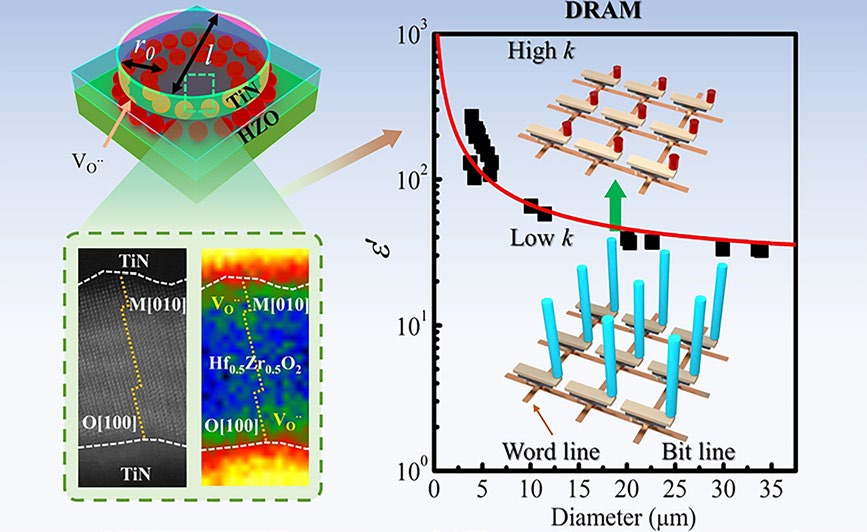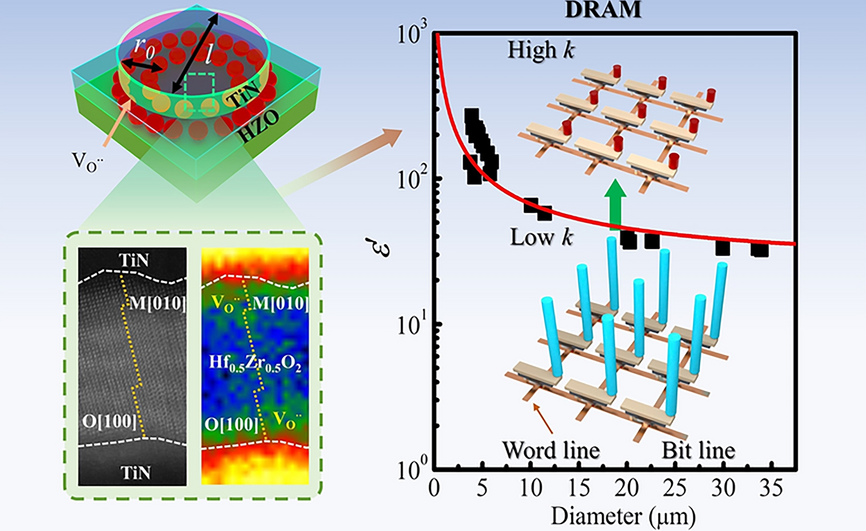Ultrahigh Dielectric Permittivity of a Micron-Sized Hf0.5Zr0.5O2 Thin-Film Capacitor After Missing of a Mixed Tetragonal Phase

A research team led by Professors Yan Cheng and An Quan Jiang has published a breakthrough study in Nano-Micro Letters on the dielectric properties of micron-sized Hf0.5Zr0.5O2 (HZO) thin-film capacitors. Their work reveals how the elimination of a mixed tetragonal phase induces an unprecedented dielectric response, offering a new paradigm for integrating hafnia-based materials into advanced memory and logic devices.
Key Findings
- Ferroelectric–Nonferroelectric Transition: When the capacitor size is reduced to 3.85 μm, ferroelectricity vanishes and an ultrahigh dielectric permittivity of 1466 emerges, without requiring high-field fatigue cycling.
- Phase Evolution: Synchrotron X-ray micro-diffraction demonstrates the disappearance of the tetragonal phase, leaving a stabilized orthorhombic structure that underpins the dielectric enhancement.
- Charge Storage: The capacitor achieves a stored charge density of 183 μC cm-2 at 1.2 V/50 ns, sustaining over 1012 cycles without breakdown—an order of magnitude higher than conventional ferroelectric counterparts.
- Oxygen Vacancy Engineering: Electron energy loss spectroscopy shows preferential oxygen-vacancy accumulation near electrodes and grain boundaries, which lowers energy barriers for spontaneous oxygen migration and facilitates the phase transition.
Why It Matters
- Scalable Integration: The findings enable high-density integration of capacitors within nanoscale logic and memory architectures, surpassing limitations of conventional ferroelectric films.
- Energy Efficiency: The giant permittivity and robust cycling stability are highly attractive for dynamic random access memory (DRAM), energy-efficient CMOS devices, and future low-power electronics.
- Mechanistic Insights: By correlating dielectric performance with oxygen-vacancy ordering and phase stability, the study provides a fundamental roadmap for tailoring hafnia-based materials beyond their traditional ferroelectric role.
Future Outlook
This discovery signals a shift from incremental improvements in ferroelectric hafnia to deliberate manipulation of phase composition and defect chemistry for extreme dielectric responses. Potential research directions include:
- Reducing leakage current density through defect passivation and interface optimization.
- Extending the concept to sub-micron geometries for ultra-scaled devices.
- Exploring multifunctional coupling of dielectric, ferroelectric, and resistive switching behaviors in a single platform.
By demonstrating a fatigue-free pathway to ultrahigh permittivity, this work redefines the technological landscape of hafnium-based dielectrics. It highlights how nanoscale structural engineering and defect management can unlock new functionalities in widely used CMOS-compatible materials, bridging fundamental condensed-matter physics with urgent demands in advanced electronics.
Follow the Topic
-
Nano-Micro Letters

Nano-Micro Letters is a peer-reviewed, international, interdisciplinary and open-access journal that focus on science, experiments, engineering, technologies and applications of nano- or microscale structure and system in physics, chemistry, biology, material science, and pharmacy.






Please sign in or register for FREE
If you are a registered user on Research Communities by Springer Nature, please sign in